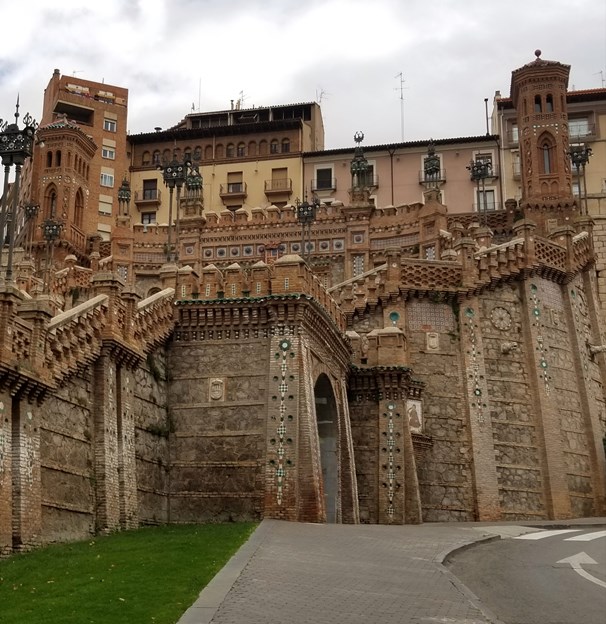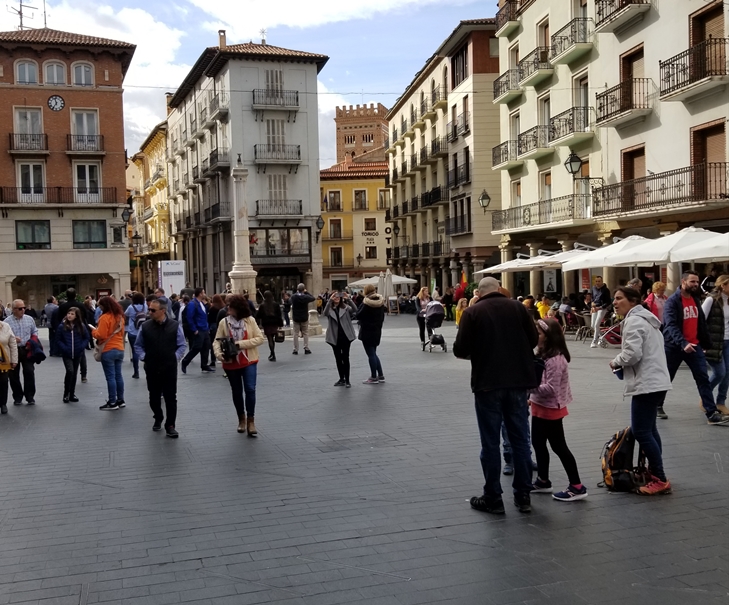Spain
Teruel – Aragon
The town of Teruel (Capital of Teruel Province) in the Aragon region of Spain, was occupied by Muslims for several centuries until the late 12th century when it was conquered by Alfonso II of Aragon. Most of the Muslim population continued to live in Teruel and maintained their customs, culture, and religion. An innovative nexus of two architectural styles – Moorish and Gothic – gave birth to the unique Mudejar architectural style, which was awarded Unesco World Heritage status in 2001.
Mudejar craftsmen were skilled in creating dazzling designs by blending the juxtaposition of simple materials such as multicolored wood, bricks, plaster, and glazed ceramics, into their structures.

From Albarracin, which we made our base for three nights, it’s a thirty-five-minute drive to Teruel. I recommend parking at the train station. Walk through the park, to Escalinata (the Staircase): a heart-stopping, neo-Mudejar work of art, built in the early 20th century. The broad steps, the side views, every angle, is an exquisite example of the melding of Mudejar materials.


At the top of the steps is the Lovers Sculpture Fountain, where couples pause to have their photos taken. Note: Don’t be put off by the steps. There is an elevator that takes one to Paseo del Óvalo and the entrance to the Old Town.

As one walks up narrow Calle El Salvador, one is greeted by the 14th century Torre del Salvador, which literally straddles the street. The façade of the multi-level tower is decorated in green and white tiles, laid in an intricate amalgam of patterns. One hundred and twenty-two steps will deliver energetic visitors to the bell tower for a panoramic view.

Onwards to Catedral de Santa Maria one of the finest examples of Mudejar architecture. Tip: We found that the best view of the Catedral, which occupies an entire small plaza, is to make a left turn on Yague de Salas as soon as you see Plaza del Torico come into view. (There is a restaurant on the corner.) Walk up one or two blocks –turn right, and you’ll walk towards the Catedral and have an unobstructed view.


You can buy tickets to visit the Catedral at the booth just inside the doors, together with a ticket to the adjacent Museo de Arte Sacre, which displays beautiful pieces of art and exquisitely embroidered, antique robes of the clergy.

Museo de Arte Sacre:
15th.century painting – Santa Ana- The Virgin and Child

Museo de Arte Sacre:
15th. century painting – San Sebastian


The interior of Catedral de Santa Maria is rich in contrasts with its variety of mediums, textures, and unique Mudejar and Christian art. The ceiling of the central nave is often referred to as the Sistine Chapel of Mudejar art, while the main altarpiece, which dates to the early 16th century, is carved entirely of wood.




From Plaza de la Catedral take narrow Calle Santa Maria, to Plaza del Torico – the heart of Old Town Teruel. Look carefully, and you’ll notice a statue of a little bull (El Torico) perched atop a column in the middle of the square, which is encircled by stores, restaurants, and bars.

Casa El Torico de Tejidos – a home built in 1912 by the Lopez family – stands out as the most beautiful building on the plaza. It dates back to the same period of neo-Mudejar architecture as La Escalinata (The Staircase). The family’s fabric store occupied the ground floor of the building leading onto the plaza, hence the name Tejidos.

Old Town Teruel is ringed by towers, which served multiple purposes: They summoned the residents to church celebrations, served as clocks reminding people of the time, alerted the population to fires, rang out for both festivals and funerals, and served as watchtowers. The last one to be built and the most beautiful is Torre e Iglesia de San Martin, on Plaza del Seminario.

Don’t attempt to visit the imposing red brick and blue Seminario, building. When we asked the gentleman at the reception desk if we could tour the building, he looked startled, troubled, and confused – then broke out in a big smile when he realized that we were ‘touristas’ and informed us that it’s now a home for the elderly.

We ended our visit to Teruel on Paseo de Óvalo. If the weather is good, the outdoor restaurants with a landscape view are a perfect spot to relax over a lunch of tapas and a glass of wine.
